See Page 1 |
2 |
3 |
4 | of the February 2024 homepage archives. Wednesday the 14th
 When writing an article about
radio beams measuring an airplane's passage through the skies, using the phrase
"crashes through the beam" is not a particularly good choice. This particular system
from a 1940 issue of Popular Science magazine reports on a system being used by
the U.S. Air Force to accurately measure airspeed over an 11-mile course. It claims
timing is accurate to 1/1,000 of a second (1 millisecond), while flying as high
as 30,000 feet. An example is given where a jet fighter made the 11.0533-mile run
in one direction in 74.25 seconds, which calculated to approximately 535 m.p.h.
(my calculator gets 536 mph). For an accuracy of ±1 ms, that means the speed
could range between 11.0533/73.25*3600 = 529 mph and 11.0533/73.25*3600 = 543 mph.
At the 536 mph rate, in 1 ms the airplane travelled 0.786 feet (9.43 inches)... When writing an article about
radio beams measuring an airplane's passage through the skies, using the phrase
"crashes through the beam" is not a particularly good choice. This particular system
from a 1940 issue of Popular Science magazine reports on a system being used by
the U.S. Air Force to accurately measure airspeed over an 11-mile course. It claims
timing is accurate to 1/1,000 of a second (1 millisecond), while flying as high
as 30,000 feet. An example is given where a jet fighter made the 11.0533-mile run
in one direction in 74.25 seconds, which calculated to approximately 535 m.p.h.
(my calculator gets 536 mph). For an accuracy of ±1 ms, that means the speed
could range between 11.0533/73.25*3600 = 529 mph and 11.0533/73.25*3600 = 543 mph.
At the 536 mph rate, in 1 ms the airplane travelled 0.786 feet (9.43 inches)...
 "Researchers at Linköping University in
Sweden have made a significant advancement in the field of
terahertz wave technology, as reported in a study published in the journal Advanced
Science. They have demonstrated that the transmission of terahertz light can be
adjusted when passed through an aerogel composed of cellulose and a conducting polymer.
This development holds great promise for enhancing applications in areas such as
advanced medical imaging and communication, highlighting the extensive potential
of high-frequency terahertz waves. The terahertz range covers wavelengths that lie
between microwaves and infrared light on the electromagnetic spectrum. It has a
very high frequency. Thanks to this, many researchers believe that the terahertz
range has great potential for use in space exploration, security technology, and
communication systems, among other things. In medical imaging, it can also be an
interesting substitute for X-ray examinations as the waves can pass through most
non-conductive materials without damaging any tissue..." "Researchers at Linköping University in
Sweden have made a significant advancement in the field of
terahertz wave technology, as reported in a study published in the journal Advanced
Science. They have demonstrated that the transmission of terahertz light can be
adjusted when passed through an aerogel composed of cellulose and a conducting polymer.
This development holds great promise for enhancing applications in areas such as
advanced medical imaging and communication, highlighting the extensive potential
of high-frequency terahertz waves. The terahertz range covers wavelengths that lie
between microwaves and infrared light on the electromagnetic spectrum. It has a
very high frequency. Thanks to this, many researchers believe that the terahertz
range has great potential for use in space exploration, security technology, and
communication systems, among other things. In medical imaging, it can also be an
interesting substitute for X-ray examinations as the waves can pass through most
non-conductive materials without damaging any tissue..."
 These 1930s vintage
multi-component vacuum tubes were actually the first examples of integrated
circuits insofar as they incorporated two or more different types of amplifiers,
or amplifiers and diodes. Just as with semiconductor integrated circuits, isolation
between elements was a concern and necessitated additional screen grids for that
purpose. The triode hexode was developed specifically to solve the issue of degenerative
feedback squelching intended oscillations in the newfangled higher frequency shortwave
radio sets that were all the rage back in the day. It combined a triode for the
oscillator circuit and the hexode was the "frequency changer," aka mixer or downconverter... These 1930s vintage
multi-component vacuum tubes were actually the first examples of integrated
circuits insofar as they incorporated two or more different types of amplifiers,
or amplifiers and diodes. Just as with semiconductor integrated circuits, isolation
between elements was a concern and necessitated additional screen grids for that
purpose. The triode hexode was developed specifically to solve the issue of degenerative
feedback squelching intended oscillations in the newfangled higher frequency shortwave
radio sets that were all the rage back in the day. It combined a triode for the
oscillator circuit and the hexode was the "frequency changer," aka mixer or downconverter...
 I don't usually
bother replicating Internet memes here on RF Cafe, but this one is relevant enough
to our world that it is worth posting. Nobody objects to addressing a medical doctor,
dentist, veterinarian, or even a psychologist as "Dr. So-and-So," because they practice
treating and curing issues of humans and/or animals; i.e. living, breathing entities
with feelings and emotions. College professors are also accorded the courtesy. Whether
or not all holders of a
doctorate degree should routinely be addressed as "Dr. This-or-That" is a matter
of personal preference. Lawyers hold doctorate degrees in jurisprudence, but nobody
calls them "Dr. SaS" Nurse practitioners hold a doctorate in nursing practice,
but they are not called "Dr. ToT." No Ph.D.-degreed engineer, scientist, mathematician,
biologist, or other such person I have known ever insisted on being referred to
as "Dr. Such-n-Such." My habit is to address him or her as "Dr. SnS" unless
told it is not necessary, which from what I remember has always been the case. Some
self-important holders of doctorate degrees insist on being addressed as "Dr. I'm-Better-Than-You-Because-I-Hold-a-Doctorate-Degree-Even-Though-It's-Not-Very-Hard-to-Earn-Compared-to-a-Doctorate-in-Many-Other-Fields."
A certain politician's wife with a doctorate in education comes to mind. One moron
on a TV network round table actually stated in reference to her being the perfect
candidate for Surgeon General, "...she's a hell of a doctor. She's an amazing doctor."
Ignorance is bliss only for the ignorant. I don't usually
bother replicating Internet memes here on RF Cafe, but this one is relevant enough
to our world that it is worth posting. Nobody objects to addressing a medical doctor,
dentist, veterinarian, or even a psychologist as "Dr. So-and-So," because they practice
treating and curing issues of humans and/or animals; i.e. living, breathing entities
with feelings and emotions. College professors are also accorded the courtesy. Whether
or not all holders of a
doctorate degree should routinely be addressed as "Dr. This-or-That" is a matter
of personal preference. Lawyers hold doctorate degrees in jurisprudence, but nobody
calls them "Dr. SaS" Nurse practitioners hold a doctorate in nursing practice,
but they are not called "Dr. ToT." No Ph.D.-degreed engineer, scientist, mathematician,
biologist, or other such person I have known ever insisted on being referred to
as "Dr. Such-n-Such." My habit is to address him or her as "Dr. SnS" unless
told it is not necessary, which from what I remember has always been the case. Some
self-important holders of doctorate degrees insist on being addressed as "Dr. I'm-Better-Than-You-Because-I-Hold-a-Doctorate-Degree-Even-Though-It's-Not-Very-Hard-to-Earn-Compared-to-a-Doctorate-in-Many-Other-Fields."
A certain politician's wife with a doctorate in education comes to mind. One moron
on a TV network round table actually stated in reference to her being the perfect
candidate for Surgeon General, "...she's a hell of a doctor. She's an amazing doctor."
Ignorance is bliss only for the ignorant.
 These two
electronics-themed comics appeared in the August 1955 edition of Popular
Electronics magazine. The artist who created the comic on page 116 likely had
no idea what a trend he was starting. Over the years of researching vintage television
restoration projects, I have seen countless examples of people having converted
old TV cabinets into liquor cabinets, clothes armoires, toy storage chests, tool
boxes, and pet beds. I'm tempted to consider them desecrations of fine technical
and woodworking craft, but I suppose I should be grateful that they at least escaped
the landfill - at least for now. Once the owners die, their kids will just toss
the repurposed sets out. The page 177 comic is from none other than Carl Kohler,
who drew many comics and authored many tech-related stories for magazines. At the
bottom of the page is a huge list with more than 225 other collections of electronics-themed
comics from vintage magazines like Electronics World, Radio and Television News,
Radio Craft, and others. As usual, I took the liberty of colorizing the comics... These two
electronics-themed comics appeared in the August 1955 edition of Popular
Electronics magazine. The artist who created the comic on page 116 likely had
no idea what a trend he was starting. Over the years of researching vintage television
restoration projects, I have seen countless examples of people having converted
old TV cabinets into liquor cabinets, clothes armoires, toy storage chests, tool
boxes, and pet beds. I'm tempted to consider them desecrations of fine technical
and woodworking craft, but I suppose I should be grateful that they at least escaped
the landfill - at least for now. Once the owners die, their kids will just toss
the repurposed sets out. The page 177 comic is from none other than Carl Kohler,
who drew many comics and authored many tech-related stories for magazines. At the
bottom of the page is a huge list with more than 225 other collections of electronics-themed
comics from vintage magazines like Electronics World, Radio and Television News,
Radio Craft, and others. As usual, I took the liberty of colorizing the comics...
 With more than 1000
custom-built symbols, this has got to be the most comprehensive set of
Visio Symbols
available for RF, analog, and digital system and schematic drawings! Every object
has been built to fit proportionally on the provided A-, B- and C-size drawing page
templates (or can use your own). Symbols are provided for equipment racks and test
equipment, system block diagrams, conceptual drawings, and schematics. Unlike previous
versions, these are NOT Stencils, but instead are all contained on tabbed pages
within a single Visio document. That puts everything in front of you in its full
glory. Just copy and paste what you need on your drawing. The file format is XML
so everything plays nicely with Visio 2013 and later... With more than 1000
custom-built symbols, this has got to be the most comprehensive set of
Visio Symbols
available for RF, analog, and digital system and schematic drawings! Every object
has been built to fit proportionally on the provided A-, B- and C-size drawing page
templates (or can use your own). Symbols are provided for equipment racks and test
equipment, system block diagrams, conceptual drawings, and schematics. Unlike previous
versions, these are NOT Stencils, but instead are all contained on tabbed pages
within a single Visio document. That puts everything in front of you in its full
glory. Just copy and paste what you need on your drawing. The file format is XML
so everything plays nicely with Visio 2013 and later...
 Providing full solution service is our motto,
not just selling goods. RF &
Connector Technology has persistently pursued a management policy stressing
quality assurance system and technological advancement. From your very first contact,
you will be supported by competent RF specialists; all of them have several years
of field experience in this industry allowing them to suggest a fundamental solution
and troubleshooting approach. Coaxial RF connectors, cable assemblies, antennas,
terminations, attenuators, couplers, dividers, and more. Practically, we put priority
on process inspection at each step of workflow as well as during final inspection
in order to actualize "Zero Defects." Providing full solution service is our motto,
not just selling goods. RF &
Connector Technology has persistently pursued a management policy stressing
quality assurance system and technological advancement. From your very first contact,
you will be supported by competent RF specialists; all of them have several years
of field experience in this industry allowing them to suggest a fundamental solution
and troubleshooting approach. Coaxial RF connectors, cable assemblies, antennas,
terminations, attenuators, couplers, dividers, and more. Practically, we put priority
on process inspection at each step of workflow as well as during final inspection
in order to actualize "Zero Defects."
Tuesday the 13th
 In 1949, when this news items appeared in
Popular Science magazine, the only drones in use were those used for target
practice by the military. The term "drone" came from the sound their small internal
combustion engines made. The remote control systems used to guide them were typically
bulky, heavy units both for the ground-based transmitters and the airplane-based
receivers. There were no drone helicopters or multi-rotor craft at the time. Not
many people even conjured futuristic thoughts of them. Instead, some radio and television
receiver installation teams used
helium-filled balloons to float antennas around the site to determine at what
position and height the best interference-free signal was provided. Steering would
have been accomplished by towing the craft around while varying the altitude. It
was a very ingenuous scheme. Note that the article refers to use of a Kytoon™, which
is a sort of portmanteau for kite + balloon. You might be interested in my related
concept for a Drone-Based Field Measurement System™... In 1949, when this news items appeared in
Popular Science magazine, the only drones in use were those used for target
practice by the military. The term "drone" came from the sound their small internal
combustion engines made. The remote control systems used to guide them were typically
bulky, heavy units both for the ground-based transmitters and the airplane-based
receivers. There were no drone helicopters or multi-rotor craft at the time. Not
many people even conjured futuristic thoughts of them. Instead, some radio and television
receiver installation teams used
helium-filled balloons to float antennas around the site to determine at what
position and height the best interference-free signal was provided. Steering would
have been accomplished by towing the craft around while varying the altitude. It
was a very ingenuous scheme. Note that the article refers to use of a Kytoon™, which
is a sort of portmanteau for kite + balloon. You might be interested in my related
concept for a Drone-Based Field Measurement System™...
 Who knew
sand theft was a serious problem? According to an article in the February 2024
issue of Scientific American magazine, illegal sand mining from the shores
of oceans, lakes, and rivers involves a global cabals of bad guys (and girls) scooping
up billions of tons of the stuff primarily in the manufacturing of concrete. The
ecological impact includes ruination of fauna and flora as well as water tables
and flooding due to runoff on less absorptive soil. "The greatest demand comes
from China, which used more cement in 3 years (6.6 gigatons from 2011 through 2013)
than the U.S. used in the entire 20th century (4.5 gigatons)." Meanwhile China
is accorded "developing nation" status by the
World Health Organization (WHO) and is permitted "special and differential treatment
provisions." A Web search on "sand mafia" turns up many similar reports: see
here,
here, and
here. Wikipedia has an entry for
sand theft. The breadth and
depth of corruption of every sort seems to have no limit. Workers are often poor
citizens of local villages. The ruling class perps consists of politicians, industry,
governments, and academia. They all must work in unison to pull it off. Investigative
reporters who get caught collecting evidence tend to disappear or have accidents.
BTW, this is not the quartz sand used for semiconductors. Who knew
sand theft was a serious problem? According to an article in the February 2024
issue of Scientific American magazine, illegal sand mining from the shores
of oceans, lakes, and rivers involves a global cabals of bad guys (and girls) scooping
up billions of tons of the stuff primarily in the manufacturing of concrete. The
ecological impact includes ruination of fauna and flora as well as water tables
and flooding due to runoff on less absorptive soil. "The greatest demand comes
from China, which used more cement in 3 years (6.6 gigatons from 2011 through 2013)
than the U.S. used in the entire 20th century (4.5 gigatons)." Meanwhile China
is accorded "developing nation" status by the
World Health Organization (WHO) and is permitted "special and differential treatment
provisions." A Web search on "sand mafia" turns up many similar reports: see
here,
here, and
here. Wikipedia has an entry for
sand theft. The breadth and
depth of corruption of every sort seems to have no limit. Workers are often poor
citizens of local villages. The ruling class perps consists of politicians, industry,
governments, and academia. They all must work in unison to pull it off. Investigative
reporters who get caught collecting evidence tend to disappear or have accidents.
BTW, this is not the quartz sand used for semiconductors.
 The IPP-8070 from Innovative Power Products
is a
150 watt dual directional coupler that covers 20 – 1000 MHz. The 0.75
x 1.25 inch coupler has a nominal coupling value of 50.0 dB, greater than
20 dB of directivity, less than 0.3 dB insertion loss, coupled flatness of
±0.65 dB, and VSWR less than 1.30:1. This coupler has internal terminations,
offering simultaneous monitoring of forward and reflecting ports in a small package
size. The IPP-8070 is ideal for military and commercial applications for broadcast,
radio, communications, aviation, test and measurement, and ISM programs. It is supplied
on Tape & Reel for high volume Pick-N-Place manufacturing equipment. View IPP-8070
Detailed Product Specs: Visit our product page to download drawing PDF, view typical
test data, and for s-parameters, PCB mounting footprint, and 3D Model files. And
to use our new Interactive S-Parameters Viewer... The IPP-8070 from Innovative Power Products
is a
150 watt dual directional coupler that covers 20 – 1000 MHz. The 0.75
x 1.25 inch coupler has a nominal coupling value of 50.0 dB, greater than
20 dB of directivity, less than 0.3 dB insertion loss, coupled flatness of
±0.65 dB, and VSWR less than 1.30:1. This coupler has internal terminations,
offering simultaneous monitoring of forward and reflecting ports in a small package
size. The IPP-8070 is ideal for military and commercial applications for broadcast,
radio, communications, aviation, test and measurement, and ISM programs. It is supplied
on Tape & Reel for high volume Pick-N-Place manufacturing equipment. View IPP-8070
Detailed Product Specs: Visit our product page to download drawing PDF, view typical
test data, and for s-parameters, PCB mounting footprint, and 3D Model files. And
to use our new Interactive S-Parameters Viewer...
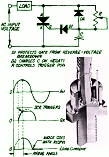 Did you know that General Electric introduced
the first
silicon-controlled rectifier (SCR) for commercial use? It was in 1957 when this
article appeared in Popular Electronics magazine. The SCR was one of the first really
high power devices in the semiconductor industry, not for its voltage and power
gain, but for its ability to switch very large currents on and off while having
a relatively low "on" voltage drop. This article gets into the basic theory, operation,
and application of the SCR. The S-band airport surveillance radar that I worked
on in the USAF originally used a vacuum tube thyratron to trigger the magnetron's
pulse forming network, but that tube was replaced with a solid state SCR circuit
that plugged directly into the original thyratron tube socket... Did you know that General Electric introduced
the first
silicon-controlled rectifier (SCR) for commercial use? It was in 1957 when this
article appeared in Popular Electronics magazine. The SCR was one of the first really
high power devices in the semiconductor industry, not for its voltage and power
gain, but for its ability to switch very large currents on and off while having
a relatively low "on" voltage drop. This article gets into the basic theory, operation,
and application of the SCR. The S-band airport surveillance radar that I worked
on in the USAF originally used a vacuum tube thyratron to trigger the magnetron's
pulse forming network, but that tube was replaced with a solid state SCR circuit
that plugged directly into the original thyratron tube socket...
 "China's third and newest aircraft carrier,
the Fujian, has yet to undergo sea trials but its design details - including an
advanced 'all in one' mast - are gradually being revealed. Fujian's much talked
about electromagnetic plane catapults were seen on state television for the first
time early this month, showing that it has one less launch track than the USS Gerald
R. Ford - the only other aircraft carrier in the world equipped with the technology.
The US Navy's newest aircraft carrier is also bigger than the Fujian and nuclear-powered,
while the Fujian relies on conventional power. But there is another point of difference:
their masts. The Ford's 'island' – or command center - has a
towering mast with an array of antennas and sensors. However, those antennas
go almost unseen on the Fujian. Its island is enclosed in a grey composite material,
a minimalist design seen in many of the Chinese navy's latest warships, including
the Type 055 destroyer. The principles and innovations behind this 'multifunctional
integrated electronic mast' were recently unveiled in a paper by scientists from
the Nanjing Research Institute of Electronics Technology who were involved in developing
the technology. The team, led by engineering scientist Li Shengyan, believe this
technology will have a significant impact on warfare in the future, according to
their paper in Chinese journal Shipboard Electronic Countermeasure last month. Their
comparison of the Chinese and US masts suggests the Fujian system could be well
ahead of the Ford's..." "China's third and newest aircraft carrier,
the Fujian, has yet to undergo sea trials but its design details - including an
advanced 'all in one' mast - are gradually being revealed. Fujian's much talked
about electromagnetic plane catapults were seen on state television for the first
time early this month, showing that it has one less launch track than the USS Gerald
R. Ford - the only other aircraft carrier in the world equipped with the technology.
The US Navy's newest aircraft carrier is also bigger than the Fujian and nuclear-powered,
while the Fujian relies on conventional power. But there is another point of difference:
their masts. The Ford's 'island' – or command center - has a
towering mast with an array of antennas and sensors. However, those antennas
go almost unseen on the Fujian. Its island is enclosed in a grey composite material,
a minimalist design seen in many of the Chinese navy's latest warships, including
the Type 055 destroyer. The principles and innovations behind this 'multifunctional
integrated electronic mast' were recently unveiled in a paper by scientists from
the Nanjing Research Institute of Electronics Technology who were involved in developing
the technology. The team, led by engineering scientist Li Shengyan, believe this
technology will have a significant impact on warfare in the future, according to
their paper in Chinese journal Shipboard Electronic Countermeasure last month. Their
comparison of the Chinese and US masts suggests the Fujian system could be well
ahead of the Ford's..."
 You probably will not be surprised to read
Popular Electronics magazine editor Oliver Ferrell's comments in this 1970
issue on the costs and implications of
handling the large volumes of postal mail from readers that magazines typically
received. Not having e-mail back in the day had both its advantages and disadvantages.
The main advantage of having just paper and envelope mail (aka snail mail) is that
only serious people with concerns would bother to write and pay for postage, whereas
with e-mail very little effort and no out-of-pocket cost is required to fire off
a note for any reason. A disadvantage of not having e-mail is that humans needed
to open, read, and decide how to respond to each letter, whereas software algorithms
- nowadays referred to as artificial intelligence (AI) - can do the heavy lifting
with e-mail... You probably will not be surprised to read
Popular Electronics magazine editor Oliver Ferrell's comments in this 1970
issue on the costs and implications of
handling the large volumes of postal mail from readers that magazines typically
received. Not having e-mail back in the day had both its advantages and disadvantages.
The main advantage of having just paper and envelope mail (aka snail mail) is that
only serious people with concerns would bother to write and pay for postage, whereas
with e-mail very little effort and no out-of-pocket cost is required to fire off
a note for any reason. A disadvantage of not having e-mail is that humans needed
to open, read, and decide how to respond to each letter, whereas software algorithms
- nowadays referred to as artificial intelligence (AI) - can do the heavy lifting
with e-mail...
 Banner Ads are rotated in all locations
on the page! RF Cafe typically receives 8,000-15,000 visits each
weekday. RF Cafe
is a favorite of engineers, technicians, hobbyists, and students all over the world.
With more than 17,000 pages in the Google search index, RF Cafe returns in
favorable positions on many types of key searches, both for text and images.
Your Banner Ads are displayed on average 280,000 times per year! New content
is added on a daily basis, which keeps the major search engines interested enough
to spider it multiple times each day. Items added on the homepage often can be found
in a Google search within a few hours of being posted. If you need your company news to be seen, RF Cafe is the
place to be... Banner Ads are rotated in all locations
on the page! RF Cafe typically receives 8,000-15,000 visits each
weekday. RF Cafe
is a favorite of engineers, technicians, hobbyists, and students all over the world.
With more than 17,000 pages in the Google search index, RF Cafe returns in
favorable positions on many types of key searches, both for text and images.
Your Banner Ads are displayed on average 280,000 times per year! New content
is added on a daily basis, which keeps the major search engines interested enough
to spider it multiple times each day. Items added on the homepage often can be found
in a Google search within a few hours of being posted. If you need your company news to be seen, RF Cafe is the
place to be...
Monday the 12th
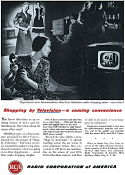 Radio Corporation of America (RCA) engineers
and system planners probably did not have the late-night Home Shopping Network (HSN)
in mind when they ran this promotion in a 1948 issue of Popular Science
magazine. Having their idea materialize in the form of pitching cheap jewelry, furniture,
and clothing - and later computers - would likely have embarrassed them. HSN-type
shows are routinely mocked and ridiculed. RCA actually envisioned what we have today
in the form of e-commerce on the Internet. A lot of people use the same display
for both Internet and television (smartphone and/or large screen TVs), so in a way,
the original vision has come to fruition. What RCA futurists probably did not envision
was a product delivery system which would in most cases move everything from friendship
rings to bookshelves staged at warehouses into homes in a day or two. Credit cards
were not widely available until the 1960s, but Cash on Delivery (COD) was, so that
addressed the payment issue... Radio Corporation of America (RCA) engineers
and system planners probably did not have the late-night Home Shopping Network (HSN)
in mind when they ran this promotion in a 1948 issue of Popular Science
magazine. Having their idea materialize in the form of pitching cheap jewelry, furniture,
and clothing - and later computers - would likely have embarrassed them. HSN-type
shows are routinely mocked and ridiculed. RCA actually envisioned what we have today
in the form of e-commerce on the Internet. A lot of people use the same display
for both Internet and television (smartphone and/or large screen TVs), so in a way,
the original vision has come to fruition. What RCA futurists probably did not envision
was a product delivery system which would in most cases move everything from friendship
rings to bookshelves staged at warehouses into homes in a day or two. Credit cards
were not widely available until the 1960s, but Cash on Delivery (COD) was, so that
addressed the payment issue...
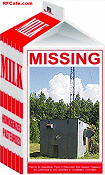 How
do you hide an elephant? That old joke came to mind when I saw this story about
a missing 200-foot radio tower owned by
station WJLX in Jasper, Alabama. "Brett Elmore, general manager of WJLX 101.5 FM/1240
AM, expressed hope that someone would come forward with information to help law
enforcement apprehend the culprits. Elmore was taken aback by the audacity of the
theft. 'I've been trying all weekend to make sense of it, but I just can't. I've
been involved in the radio business my whole life, and I've never heard of anything
like this. I thought I had seen it all,' Elmore said. Elmore explained that they
were alerted to the theft on Friday when a bush hog crew arrived at the WJLX tower
site in Jasper to clean up the property, only to find it completely cleared out
by the thieves. 'When he called me on Friday and said, 'the tower is gone,' I couldn't
believe it. I asked him if he was sure he was at the right place. He responded,
'The tower is gone. Wires are scattered everywhere,'' Elmore added. The station
is currently working with the FCC to obtain temporary authority to continue operations
while they rebuild the AM side of their operations. The duration of the rebuilding
efforts remains uncertain..." How
do you hide an elephant? That old joke came to mind when I saw this story about
a missing 200-foot radio tower owned by
station WJLX in Jasper, Alabama. "Brett Elmore, general manager of WJLX 101.5 FM/1240
AM, expressed hope that someone would come forward with information to help law
enforcement apprehend the culprits. Elmore was taken aback by the audacity of the
theft. 'I've been trying all weekend to make sense of it, but I just can't. I've
been involved in the radio business my whole life, and I've never heard of anything
like this. I thought I had seen it all,' Elmore said. Elmore explained that they
were alerted to the theft on Friday when a bush hog crew arrived at the WJLX tower
site in Jasper to clean up the property, only to find it completely cleared out
by the thieves. 'When he called me on Friday and said, 'the tower is gone,' I couldn't
believe it. I asked him if he was sure he was at the right place. He responded,
'The tower is gone. Wires are scattered everywhere,'' Elmore added. The station
is currently working with the FCC to obtain temporary authority to continue operations
while they rebuild the AM side of their operations. The duration of the rebuilding
efforts remains uncertain..."
 Something that is always in the forefront
of my mind when reading these articles from vintage American electronics magazines
is how most of the products - including even the smallest components - were made
in the United States. When I read vintage British electronics magazines (e.g., Wireless
World), most of the products were produced in Europe. The technical and manufacturing
know-how was spread throughout the regions of the Earth where its citizens dreamed
up and realized the wonders that made the modern world. Part of the reason is supply
and distribution chains were not as capable due to communications and transportation
limitations. Nowadays, it seems
almost nothing is made in the countries where the products are designed - except
in places like China where so much technology has been exported to there that their
people (very smart folks) are now designing and manufacturing their own products.
Consequently, a large portion of the population in the U.S., England, France, Germany,
etc., no longer has the skills to do the job. They don't have any idea how such
things are accomplished since for most (or all) of their lives almost everything
they own has come with a "Made in China, or Vietnam, or Myanmar, or Chile, etc."
marked on it. As late as the early 2000s, fairly stringent technology export restrictions
still were in place in order to keep the latest and greatest capability here at
home for strategic purposes, but it seems almost nothing is protected anymore... Something that is always in the forefront
of my mind when reading these articles from vintage American electronics magazines
is how most of the products - including even the smallest components - were made
in the United States. When I read vintage British electronics magazines (e.g., Wireless
World), most of the products were produced in Europe. The technical and manufacturing
know-how was spread throughout the regions of the Earth where its citizens dreamed
up and realized the wonders that made the modern world. Part of the reason is supply
and distribution chains were not as capable due to communications and transportation
limitations. Nowadays, it seems
almost nothing is made in the countries where the products are designed - except
in places like China where so much technology has been exported to there that their
people (very smart folks) are now designing and manufacturing their own products.
Consequently, a large portion of the population in the U.S., England, France, Germany,
etc., no longer has the skills to do the job. They don't have any idea how such
things are accomplished since for most (or all) of their lives almost everything
they own has come with a "Made in China, or Vietnam, or Myanmar, or Chile, etc."
marked on it. As late as the early 2000s, fairly stringent technology export restrictions
still were in place in order to keep the latest and greatest capability here at
home for strategic purposes, but it seems almost nothing is protected anymore...
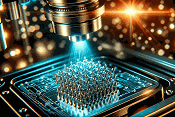 "Researchers at the Georgia Institute of
Technology have developed a light-based means of
printing nano-sized metal structures that is significantly faster and cheaper
than any technology currently available. It is a scalable solution that could transform
a scientific field long reliant on technologies that are prohibitively expensive
and slow. The breakthrough has the potential to bring new technologies out of labs
and into the world. Advantages of the New Technique Technological advances in many
fields rely on the ability to print metallic structures that are nano-sized - a
scale hundreds of times smaller than the width of a human hair. Sourabh Saha, assistant
professor in the George W. Woodruff School of Mechanical Engineering, and Jungho
Choi, a Ph.D. student in Saha's lab, developed a technique for printing metal nanostructures
that is 480 times faster and 35 times cheaper than the current conventional method..." "Researchers at the Georgia Institute of
Technology have developed a light-based means of
printing nano-sized metal structures that is significantly faster and cheaper
than any technology currently available. It is a scalable solution that could transform
a scientific field long reliant on technologies that are prohibitively expensive
and slow. The breakthrough has the potential to bring new technologies out of labs
and into the world. Advantages of the New Technique Technological advances in many
fields rely on the ability to print metallic structures that are nano-sized - a
scale hundreds of times smaller than the width of a human hair. Sourabh Saha, assistant
professor in the George W. Woodruff School of Mechanical Engineering, and Jungho
Choi, a Ph.D. student in Saha's lab, developed a technique for printing metal nanostructures
that is 480 times faster and 35 times cheaper than the current conventional method..."
 Here are a couple more
electronics-themed comics from vintage Popular Electronics magazines.
Only one comic appeared in each of the May 1962 and April 1974 issues, so I combined
them onto a single page. The comic from 1962 has a message I had not considered
before about otherwise unassociated businesses horning in on a traditional business'
purview, in this case drug stores selling replacement vacuum tubes, thereby robbing
sales from the electronics repair shops. Regarding the other comic, consider if
the roles were reversed and the husband was about to beat the wife with a club.
Would that be considered funny? Personally, I take it in the manner of good humor
intended, but way too many people are way too easily offended... Here are a couple more
electronics-themed comics from vintage Popular Electronics magazines.
Only one comic appeared in each of the May 1962 and April 1974 issues, so I combined
them onto a single page. The comic from 1962 has a message I had not considered
before about otherwise unassociated businesses horning in on a traditional business'
purview, in this case drug stores selling replacement vacuum tubes, thereby robbing
sales from the electronics repair shops. Regarding the other comic, consider if
the roles were reversed and the husband was about to beat the wife with a club.
Would that be considered funny? Personally, I take it in the manner of good humor
intended, but way too many people are way too easily offended...
 RF Cascade Workbook is the next phase in the evolution of RF Cafe's long-running
series, RF Cascade Workbook. Chances are you have never used a spreadsheet
quite like this (click
here for screen capture). It is a full-featured RF system cascade parameter
and frequency planner that includes filters and mixers for a mere $45. Built in
MS Excel, using RF Cascade Workbook 2018 is a cinch and the format
is entirely customizable. It is significantly easier and faster than using a multi-thousand
dollar simulator when a high level system analysis is all that is needed. An intro
video takes you through the main features...
RF Cascade Workbook is the next phase in the evolution of RF Cafe's long-running
series, RF Cascade Workbook. Chances are you have never used a spreadsheet
quite like this (click
here for screen capture). It is a full-featured RF system cascade parameter
and frequency planner that includes filters and mixers for a mere $45. Built in
MS Excel, using RF Cascade Workbook 2018 is a cinch and the format
is entirely customizable. It is significantly easier and faster than using a multi-thousand
dollar simulator when a high level system analysis is all that is needed. An intro
video takes you through the main features...
 Innovative Power Products has been designing
and manufacturing RF and Microwave passive components since 2005. We use the latest
design tools available to build our baluns, 90-degree couplers, directional couplers,
combiners/dividers, single-ended transformers, resistors, terminations, and custom
products. Applications in military, medical, industrial, and commercial markets
are serviced around the world. Products listed on the website link to detailed mechanical
drawings, electrical specifications, and performance data. If you cannot find a
product that meets your requirements on our website, contact us to speak with one
of our experienced design engineers about your project. Innovative Power Products has been designing
and manufacturing RF and Microwave passive components since 2005. We use the latest
design tools available to build our baluns, 90-degree couplers, directional couplers,
combiners/dividers, single-ended transformers, resistors, terminations, and custom
products. Applications in military, medical, industrial, and commercial markets
are serviced around the world. Products listed on the website link to detailed mechanical
drawings, electrical specifications, and performance data. If you cannot find a
product that meets your requirements on our website, contact us to speak with one
of our experienced design engineers about your project.
Sunday the 11th
 This custom RF Cafe
engineering & science themed crossword puzzle for February 11th contains
only clues and terms associated with engineering, science, physical, astronomy,
mathematics, chemistry, etc., which I have built up over more than two decades.
Being the 11th day, words containing the letter "K" are marked with an asterisk
(*). Many new words and company names have been added that had not even been added
to the world's technical lexicon when I started in the year 2002. As always, this
crossword contains no names of politicians, mountain ranges, exotic foods or plants,
movie stars, or anything of the sort unless it/he/she is related to this puzzle's
technology theme. You might, however, encounter the name of a movie star like Hedy
Lamarr or a geographical location like Tunguska, Russia, for reasons which, if you
don't already know, might surprise you. The technically inclined cruciverbalists
amongst us will appreciate the effort. A full list of all RF Cafe crosswords is
at the page bottom. Enjoy! This custom RF Cafe
engineering & science themed crossword puzzle for February 11th contains
only clues and terms associated with engineering, science, physical, astronomy,
mathematics, chemistry, etc., which I have built up over more than two decades.
Being the 11th day, words containing the letter "K" are marked with an asterisk
(*). Many new words and company names have been added that had not even been added
to the world's technical lexicon when I started in the year 2002. As always, this
crossword contains no names of politicians, mountain ranges, exotic foods or plants,
movie stars, or anything of the sort unless it/he/she is related to this puzzle's
technology theme. You might, however, encounter the name of a movie star like Hedy
Lamarr or a geographical location like Tunguska, Russia, for reasons which, if you
don't already know, might surprise you. The technically inclined cruciverbalists
amongst us will appreciate the effort. A full list of all RF Cafe crosswords is
at the page bottom. Enjoy!
 This assortment of custom-designed themes
by RF Cafe includes T-Shirts, Mouse Pads, Clocks, Tote Bags, Coffee Mugs and Steins,
Purses, Sweatshirts, Baseball Caps, and more, all sporting my amazingly clever "RF Engineers - We Are the World's
Matchmakers" Smith chart design. These would make excellent gifts for husbands,
wives, kids, significant others, and for handing out at company events or as rewards
for excellent service. My graphic has been ripped off by other people and used on
their products, so please be sure to purchase only official RF Cafe gear. I only
make a couple bucks on each sale - the rest goes to Cafe Press. It's a great way
to help support RF Cafe. Thanks... This assortment of custom-designed themes
by RF Cafe includes T-Shirts, Mouse Pads, Clocks, Tote Bags, Coffee Mugs and Steins,
Purses, Sweatshirts, Baseball Caps, and more, all sporting my amazingly clever "RF Engineers - We Are the World's
Matchmakers" Smith chart design. These would make excellent gifts for husbands,
wives, kids, significant others, and for handing out at company events or as rewards
for excellent service. My graphic has been ripped off by other people and used on
their products, so please be sure to purchase only official RF Cafe gear. I only
make a couple bucks on each sale - the rest goes to Cafe Press. It's a great way
to help support RF Cafe. Thanks...
Friday the 9th
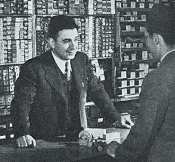 Few things give away the era of an electronics
article than having capacitor values presented in units of micromicrofarads (mmf.)
rather than picofarads (pF). The change is not merely the use of micromicro (10-6
x 10-6 = 10-12), but also the use of lower case "m" to designate micro (as opposed
to milli). Periods are no longer placed after the abbreviation. The lower case Greek
letter "μ" was adopted for use in 1960 by the National Bureau of Standards (NBS,
now NTIA) and the International Committee on Weights and Measures. Four new prefixes
were proclaimed tera, meaning trillion (1012); giga (109), meaning billion; nano,
billionth (10-9), and pico, trillionth (10-12). Finally, "farad" nowadays is printed
as an upper case "F." Not many people are in the market for
replacement electronic parts since most components require special soldering
equipment to remove and mount. Components in 1948, when this article appeared in
Popular Science magazine were fairly easily serviced... Few things give away the era of an electronics
article than having capacitor values presented in units of micromicrofarads (mmf.)
rather than picofarads (pF). The change is not merely the use of micromicro (10-6
x 10-6 = 10-12), but also the use of lower case "m" to designate micro (as opposed
to milli). Periods are no longer placed after the abbreviation. The lower case Greek
letter "μ" was adopted for use in 1960 by the National Bureau of Standards (NBS,
now NTIA) and the International Committee on Weights and Measures. Four new prefixes
were proclaimed tera, meaning trillion (1012); giga (109), meaning billion; nano,
billionth (10-9), and pico, trillionth (10-12). Finally, "farad" nowadays is printed
as an upper case "F." Not many people are in the market for
replacement electronic parts since most components require special soldering
equipment to remove and mount. Components in 1948, when this article appeared in
Popular Science magazine were fairly easily serviced...
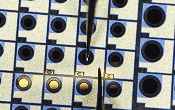 "Over
the past decade, one of the biggest stories in semiconductors has been a surprise
eclipsing of traditional silicon - in the field of power electronics, where silicon
carbide (SiC) and gallium nitride (GaN) have raced past silicon to capture multibilllion-dollar
segments of the market. And as major applications fell to these upstarts, with their
superior attributes, a question naturally arose. What would be the next new power
semiconductor - the one whose superior capabilities would grab major market share
from SiC and GaN? Attention has focused on three candidates:
gallium oxide, diamond, and
aluminum nitride (AlN). All of them have remarkable attributes, as well as fundamental
weaknesses that have so far precluded commercial success. Now, however, AlN's prospects
have improved enormously, thanks to several recent breakthroughs, including a technological
advance at Nagoya University..." "Over
the past decade, one of the biggest stories in semiconductors has been a surprise
eclipsing of traditional silicon - in the field of power electronics, where silicon
carbide (SiC) and gallium nitride (GaN) have raced past silicon to capture multibilllion-dollar
segments of the market. And as major applications fell to these upstarts, with their
superior attributes, a question naturally arose. What would be the next new power
semiconductor - the one whose superior capabilities would grab major market share
from SiC and GaN? Attention has focused on three candidates:
gallium oxide, diamond, and
aluminum nitride (AlN). All of them have remarkable attributes, as well as fundamental
weaknesses that have so far precluded commercial success. Now, however, AlN's prospects
have improved enormously, thanks to several recent breakthroughs, including a technological
advance at Nagoya University..."
 John Frye, as it turns out, was way ahead
of his time. Many of the somewhat zany electronics devices his fictitious teenage
experimenters cum hobbyists cum scientists cum Ham radio operators cum amateur sleuths
Carl and Jerry came up with have turned out to be products available and popular
in today's consumer marketplace. This episode from the July 1959 issue of Popular
Electronics magazine can be regarded as an early developmental version of a
wearable calorie burner facilitation device. Jerry's "Blubber Burner" sports an
un-politically-correct name and uses that element now considered to be the devil
in liquid metal form (mercury), but it managed to get the job done. FitBit bands
do not go so far as to zap you with a jolt of electric charge to get you moving
if you are idle for too long, but the concept of reminding the wearer to exercise
is not so far in principle from the Blubber Burner. Their friend Norm invented another
use for it - the first recorded use of a taser... John Frye, as it turns out, was way ahead
of his time. Many of the somewhat zany electronics devices his fictitious teenage
experimenters cum hobbyists cum scientists cum Ham radio operators cum amateur sleuths
Carl and Jerry came up with have turned out to be products available and popular
in today's consumer marketplace. This episode from the July 1959 issue of Popular
Electronics magazine can be regarded as an early developmental version of a
wearable calorie burner facilitation device. Jerry's "Blubber Burner" sports an
un-politically-correct name and uses that element now considered to be the devil
in liquid metal form (mercury), but it managed to get the job done. FitBit bands
do not go so far as to zap you with a jolt of electric charge to get you moving
if you are idle for too long, but the concept of reminding the wearer to exercise
is not so far in principle from the Blubber Burner. Their friend Norm invented another
use for it - the first recorded use of a taser...
 Anatech Electronics offers the industry's
largest portfolio of high-performance standard and customized
RF and microwave filters and filter-related products for military, commercial,
aerospace and defense, and industrial applications up to 40 GHz. Three new
filters have been announced for February 2024 - all are ceramic bandpass filters.
They include a 742 MHz bandpass filter with a 13 MHz bandwidth and maximum
insertion loss of 4.0 dB, a 751 bandpass filter with a 10 MHz bandwidth,
and a 782 bandpass filter with a 5 MHz bandwidth. Custom RF power filter and
directional couplers designs can be designed and produced with required connector
types when a standard cannot be found, or the requirements are such that a custom
approach is necessary... Anatech Electronics offers the industry's
largest portfolio of high-performance standard and customized
RF and microwave filters and filter-related products for military, commercial,
aerospace and defense, and industrial applications up to 40 GHz. Three new
filters have been announced for February 2024 - all are ceramic bandpass filters.
They include a 742 MHz bandpass filter with a 13 MHz bandwidth and maximum
insertion loss of 4.0 dB, a 751 bandpass filter with a 10 MHz bandwidth,
and a 782 bandpass filter with a 5 MHz bandwidth. Custom RF power filter and
directional couplers designs can be designed and produced with required connector
types when a standard cannot be found, or the requirements are such that a custom
approach is necessary...
 Here for radio hobbyists are a dozen
handy-dandy "kinks," otherwise known as tricks, shortcuts, or clever ideas,
that could prove useful while working in the lab at work or in your shop at home.
They appeared in the September 1935 issue of Short Wave Craft magazine,
thus, some seem a tad outdated. One kink that might be worth trying calls for immersing
an aluminum panel in a water-lye solution to achieve "a professional-looking finish."
A satin look results. A Google search on etching aluminum turns up many other methods.
Admittedly, most of these ideas would not have much application with today's ready-made
radios, antennas, power supplies, etc., but there are still people who build custom
equipment and/or repair circuits... Here for radio hobbyists are a dozen
handy-dandy "kinks," otherwise known as tricks, shortcuts, or clever ideas,
that could prove useful while working in the lab at work or in your shop at home.
They appeared in the September 1935 issue of Short Wave Craft magazine,
thus, some seem a tad outdated. One kink that might be worth trying calls for immersing
an aluminum panel in a water-lye solution to achieve "a professional-looking finish."
A satin look results. A Google search on etching aluminum turns up many other methods.
Admittedly, most of these ideas would not have much application with today's ready-made
radios, antennas, power supplies, etc., but there are still people who build custom
equipment and/or repair circuits...
 It was a lot of work, but I finally finished
a version of the "RF &
Electronics Schematic & Block Diagram Symbols"" that works well with Microsoft
Office™ programs Word™, Excel™, and Power Point™. This is an equivalent of the extensive
set of amplifier, mixer, filter, switch, connector, waveguide, digital, analog,
antenna, and other commonly used symbols for system block diagrams and schematics
created for Visio™. Each of the 1,000 or so symbols was exported individually from
Visio in the EMF file format, then imported into Word on a Drawing Canvas. The EMF
format allows an image to be scaled up or down without becoming pixelated, so all
the shapes can be resized in a document and still look good. The imported symbols
can also be UnGrouped into their original constituent parts for editing. Check them
out! It was a lot of work, but I finally finished
a version of the "RF &
Electronics Schematic & Block Diagram Symbols"" that works well with Microsoft
Office™ programs Word™, Excel™, and Power Point™. This is an equivalent of the extensive
set of amplifier, mixer, filter, switch, connector, waveguide, digital, analog,
antenna, and other commonly used symbols for system block diagrams and schematics
created for Visio™. Each of the 1,000 or so symbols was exported individually from
Visio in the EMF file format, then imported into Word on a Drawing Canvas. The EMF
format allows an image to be scaled up or down without becoming pixelated, so all
the shapes can be resized in a document and still look good. The imported symbols
can also be UnGrouped into their original constituent parts for editing. Check them
out!
 Aegis Power Systems is a leading supplier
of AC-DC and DC-DC power supplies
for custom and special applications. Aegis has been designing and building highly
reliable custom power supplies since 1995. They offer a complete line of switch
mode power supplies and power converters for a variety of markets including defense,
industrial, aircraft, VME, and telecom. Supports military, aircraft, EV, telecom,
and embedded computing applications. Design and manufacture of custom power supply
solutions to meet each customer's exacting specifications. Please visit Aegis Power
Systems today. Manufactured in the USA. Aegis Power Systems is a leading supplier
of AC-DC and DC-DC power supplies
for custom and special applications. Aegis has been designing and building highly
reliable custom power supplies since 1995. They offer a complete line of switch
mode power supplies and power converters for a variety of markets including defense,
industrial, aircraft, VME, and telecom. Supports military, aircraft, EV, telecom,
and embedded computing applications. Design and manufacture of custom power supply
solutions to meet each customer's exacting specifications. Please visit Aegis Power
Systems today. Manufactured in the USA.
Thursday the 8th
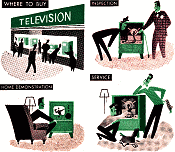 Some people like reading about the history
of nations, others about wars, and still others about mankind. Like many electronics
enthusiasts, I like reading about the history of electricity and electronics. That
fact is pretty obvious to anyone following RF Cafe over the past twenty-four years.
Evidently many have the same interest to some degree based on the amount of related
information available here and other places on the Web. Considerations when buying
a television set today is a lot like it was back in 1949 when this article appeared
in Popular Science magazine. Antennas are no longer a concern, but price, location,
size, and special features are still a factor. Of course today a person needs to
determine whether he has a wall big enough to mount an 85" flat screen rather than
whether a 12" set fits comfortable within the confines of an unused fireplace. The
price range is not so much different today, except the $200 low-end is a mere 32"
whereas the $700 model spans six feet or more. In 1949, TV was considered a modern
miracle affordable only by your more fortunate neighbors. Nowadays, anyone with
the right socioeconomic characteristics, in the right city, with the chutzpah to
just walk out of a store without paying for it... Some people like reading about the history
of nations, others about wars, and still others about mankind. Like many electronics
enthusiasts, I like reading about the history of electricity and electronics. That
fact is pretty obvious to anyone following RF Cafe over the past twenty-four years.
Evidently many have the same interest to some degree based on the amount of related
information available here and other places on the Web. Considerations when buying
a television set today is a lot like it was back in 1949 when this article appeared
in Popular Science magazine. Antennas are no longer a concern, but price, location,
size, and special features are still a factor. Of course today a person needs to
determine whether he has a wall big enough to mount an 85" flat screen rather than
whether a 12" set fits comfortable within the confines of an unused fireplace. The
price range is not so much different today, except the $200 low-end is a mere 32"
whereas the $700 model spans six feet or more. In 1949, TV was considered a modern
miracle affordable only by your more fortunate neighbors. Nowadays, anyone with
the right socioeconomic characteristics, in the right city, with the chutzpah to
just walk out of a store without paying for it...
 We have new term here: "detectorist." Maybe
the guy with the doing the digging is a "shovelist." "Researchers have long been
puzzled by the
Roman dodecahedron. More than 100 of these strange 12-sided metal objects have
been found throughout Europe - but their purpose remains unclear. Now, another discovery
in England's countryside has reignited the mystery surrounding the ancient artifacts.
A volunteer with the Norton Disney History and Archaeology Group unearthed the dodecahedron
in the Lincolnshire village of Norton Disney over the summer. The group's secretary,
Richard Parker, tells Smithsonian magazine the artifact is 'the find of a lifetime.'
'[Dodecahedrons] are one of archaeology's great enigmas,' he says. 'Our example
is remarkable. It's in an excellent condition - considering it's been buried for
1,700 years - and complete with no damage. As Parker tells Live Science's Tom Metcalfe,
the group was performing a two-week search for artifacts in a field where metal
detectorists had previously discovered Roman coins and broaches. When the dodecahedron
appeared in the excavation's final days, 'we were completely surprised by it,' says
Parker..." We have new term here: "detectorist." Maybe
the guy with the doing the digging is a "shovelist." "Researchers have long been
puzzled by the
Roman dodecahedron. More than 100 of these strange 12-sided metal objects have
been found throughout Europe - but their purpose remains unclear. Now, another discovery
in England's countryside has reignited the mystery surrounding the ancient artifacts.
A volunteer with the Norton Disney History and Archaeology Group unearthed the dodecahedron
in the Lincolnshire village of Norton Disney over the summer. The group's secretary,
Richard Parker, tells Smithsonian magazine the artifact is 'the find of a lifetime.'
'[Dodecahedrons] are one of archaeology's great enigmas,' he says. 'Our example
is remarkable. It's in an excellent condition - considering it's been buried for
1,700 years - and complete with no damage. As Parker tells Live Science's Tom Metcalfe,
the group was performing a two-week search for artifacts in a field where metal
detectorists had previously discovered Roman coins and broaches. When the dodecahedron
appeared in the excavation's final days, 'we were completely surprised by it,' says
Parker..."
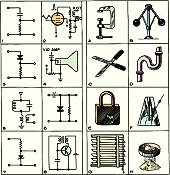 In this April 1973 challenge by Popular
Electronics magazine's quizmaster Robert Balin, you need to match each electronic
circuit on the left with its mechanical analog on the right. Most equivalencies
you have probably seen before, like with circuit numbers 7 and 8. The mechanical
equivalent for circuit number 5 might be either of two mechanical options, but one
of them them is more obviously equated with another circuit. Don't be off-put by
the vacuum tubes; simply imagine a transistor there instead. Familiarity with television
circuits helps with circuits 2 and 4. The only mechanical equivalent drawing that
presents a bit of a problem "getting," IMHO, is letter G. A list of all the quizzes
I have posted... In this April 1973 challenge by Popular
Electronics magazine's quizmaster Robert Balin, you need to match each electronic
circuit on the left with its mechanical analog on the right. Most equivalencies
you have probably seen before, like with circuit numbers 7 and 8. The mechanical
equivalent for circuit number 5 might be either of two mechanical options, but one
of them them is more obviously equated with another circuit. Don't be off-put by
the vacuum tubes; simply imagine a transistor there instead. Familiarity with television
circuits helps with circuits 2 and 4. The only mechanical equivalent drawing that
presents a bit of a problem "getting," IMHO, is letter G. A list of all the quizzes
I have posted...
 Nobody can say for sure where the saying
originated, but the veracity of "Necessity
is the mother of invention," has been evident throughout all of mankind's existence.
You have doubtless experienced it in your own life many times, sometimes in small
ways and sometimes in big ways. We cannot all be as prolific at invention as were
Archimedes, Benjamin Franklin, and Thomas Edison, but if when the need arises and
no ready solution is available, you do it yourself or do without. Such was the case
recently when my daughter's house was experiencing massive water infiltration during
major rain downpours. The previous owners had buried a drain pipe in the ground
where the rain ran off, but by now it was almost entirely blocked off with dirt.
I could have dug up and replaced the blocked portion, which was for at least four
feet, but there was no telling how much blockage there might be farther downstream,
and the pipe runs at least 80 feet to where it empties out between two buildings
- not a good plan. Instead, I dug a new trench along the entire length of the house
and fed the two corner down spouts into it along with the new collector in the middle.
One corner downspout also emptied into a clogged drain pipe, and the other just
ran onto the top of the ground. Like I said - bad planning. As can be seen in the
photos, where the roof sections converge to form a valley, there is no effective
way to install traditional gutters... Nobody can say for sure where the saying
originated, but the veracity of "Necessity
is the mother of invention," has been evident throughout all of mankind's existence.
You have doubtless experienced it in your own life many times, sometimes in small
ways and sometimes in big ways. We cannot all be as prolific at invention as were
Archimedes, Benjamin Franklin, and Thomas Edison, but if when the need arises and
no ready solution is available, you do it yourself or do without. Such was the case
recently when my daughter's house was experiencing massive water infiltration during
major rain downpours. The previous owners had buried a drain pipe in the ground
where the rain ran off, but by now it was almost entirely blocked off with dirt.
I could have dug up and replaced the blocked portion, which was for at least four
feet, but there was no telling how much blockage there might be farther downstream,
and the pipe runs at least 80 feet to where it empties out between two buildings
- not a good plan. Instead, I dug a new trench along the entire length of the house
and fed the two corner down spouts into it along with the new collector in the middle.
One corner downspout also emptied into a clogged drain pipe, and the other just
ran onto the top of the ground. Like I said - bad planning. As can be seen in the
photos, where the roof sections converge to form a valley, there is no effective
way to install traditional gutters...
 Comics in modern magazines are a rather
rare phenomenon for some reason, but they were fairly regular features up until
a couple decades ago. This set of
electronics-themed comics is from the December 1949 edition of Radio &
Television News magazine. The first one would probably not make sense to someone
not familiar with the extents to which some radio operators go to deploy antennas.
During field day events and other mobile scenarios, Hams have been using kites and
balloons to create 1/4-, 1/2-, or even full-wave vertical antennas with wires run
along the tether line, a la Benjamin Franklin. When a kite is used, because of the
wind carrying the kite away from the ground point, it is impossible to get the antenna
vertical unless the line is really long and the antenna wire is located on the most
vertical section of the line's catenary shape. The slanted antenna creates a radiation
pattern that is directed upward on the windward side and downward on the leeward
side. Under low or no wind conditions, a balloon has a better chance... Comics in modern magazines are a rather
rare phenomenon for some reason, but they were fairly regular features up until
a couple decades ago. This set of
electronics-themed comics is from the December 1949 edition of Radio &
Television News magazine. The first one would probably not make sense to someone
not familiar with the extents to which some radio operators go to deploy antennas.
During field day events and other mobile scenarios, Hams have been using kites and
balloons to create 1/4-, 1/2-, or even full-wave vertical antennas with wires run
along the tether line, a la Benjamin Franklin. When a kite is used, because of the
wind carrying the kite away from the ground point, it is impossible to get the antenna
vertical unless the line is really long and the antenna wire is located on the most
vertical section of the line's catenary shape. The slanted antenna creates a radiation
pattern that is directed upward on the windward side and downward on the leeward
side. Under low or no wind conditions, a balloon has a better chance...
 With more than 1000
custom-built stencils, this has got to be the most comprehensive set of
Visio Stencils
available for RF, analog, and digital system and schematic drawings! Every stencil
symbol has been built to fit proportionally on the included A-, B-, and C-size drawing
page templates (or use your own page if preferred). Components are provided for
system block diagrams, conceptual drawings, schematics, test equipment, racks (EIA
19", ETSI 21"), and more. Test equipment and racks are built at a 1:1 scale so that
measurements can be made directly using Visio built-in dimensioning objects. Page
templates are provided with a preset scale (changeable) for a good presentation
that can incorporate all provided symbols... With more than 1000
custom-built stencils, this has got to be the most comprehensive set of
Visio Stencils
available for RF, analog, and digital system and schematic drawings! Every stencil
symbol has been built to fit proportionally on the included A-, B-, and C-size drawing
page templates (or use your own page if preferred). Components are provided for
system block diagrams, conceptual drawings, schematics, test equipment, racks (EIA
19", ETSI 21"), and more. Test equipment and racks are built at a 1:1 scale so that
measurements can be made directly using Visio built-in dimensioning objects. Page
templates are provided with a preset scale (changeable) for a good presentation
that can incorporate all provided symbols...
 Aegis Power Systems is a leading supplier
of AC-DC and DC-DC power supplies
for custom and special applications. Aegis has been designing and building highly
reliable custom power supplies since 1995. They offer a complete line of switch
mode power supplies and power converters for a variety of markets including defense,
industrial, aircraft, VME, and telecom. Supports military, aircraft, EV, telecom,
and embedded computing applications. Design and manufacture of custom power supply
solutions to meet each customer's exacting specifications. Please visit Aegis Power
Systems today. Manufactured in the USA. Aegis Power Systems is a leading supplier
of AC-DC and DC-DC power supplies
for custom and special applications. Aegis has been designing and building highly
reliable custom power supplies since 1995. They offer a complete line of switch
mode power supplies and power converters for a variety of markets including defense,
industrial, aircraft, VME, and telecom. Supports military, aircraft, EV, telecom,
and embedded computing applications. Design and manufacture of custom power supply
solutions to meet each customer's exacting specifications. Please visit Aegis Power
Systems today. Manufactured in the USA.
These archive pages are provided in order to make it easier for you to find items
that you remember seeing on the RF Cafe homepage. Of course probably the easiest
way to find anything on the website is to use the "Search
RF Cafe" box at the top of every page.
About RF Cafe. I also
have an extensive list of
Recently Added topics.
Homepage Archive Pages
2024:
Jan |
Feb |
Mar |
Apr |
May |
Jun |
Jul |
Aug |
Sep |
Oct |
Nov |
Dec
2023:
Jan |
Feb |
Mar |
Apr |
May |
Jun |
Jul |
Aug |
Sep |
Oct |
Nov |
Dec
2022:
Jan |
Feb |
Mar |
Apr |
May |
Jun |
Jul |
Aug |
Sep |
Oct |
Nov |
Dec
2021:
Jan |
Feb |
Mar |
Apr |
May |
Jun |
Jul |
Aug |
Sep |
Oct |
Nov |
Dec
2020:
Jan |
Feb |
Mar |
Apr |
May |
Jun |
Jul |
Aug |
Sep |
Oct |
Nov |
Dec
2019:
Jan |
Feb |
Mar |
Apr |
May |
Jun |
Jul |
Aug |
Sep |
Oct |
Nov |
Dec
2018:
Jan |
Feb |
Mar |
Apr |
May |
Jun |
Jul |
Aug |
Sep |
Oct |
Nov |
Dec
2017:
Jan |
Feb |
Mar |
Apr |
May |
Jun |
Jul |
Aug |
Sep |
Oct |
Nov |
Dec
2016:
Jan |
Feb |
Mar |
Apr |
May |
Jun |
Jul |
Aug |
Sep |
Oct |
Nov |
Dec
2015:
Jan |
Feb |
Mar |
Apr |
May |
Jun |
Jul |
Aug |
Sep |
Oct |
Nov |
Dec
2014:
Jan |
Feb |
Mar |
Apr |
May |
Jun |
Jul |
Aug |
Sep |
Oct |
Nov |
Dec
2013:
Jan |
Feb |
Mar |
Apr |
May |
Jun |
Jul |
Aug |
Sep |
Oct |
Nov |
Dec
2012:
1 |
2 |
3 |
4 |
5 |
6 |
7 |
8 |
9 |
10 |
11 |
12 |
13 (no archives before 2012)
|






























 I don't usually
bother replicating Internet memes here on RF Cafe, but this one is relevant enough
to our world that it is worth posting. Nobody objects to addressing a medical doctor,
dentist, veterinarian, or even a psychologist as "Dr. So-and-So," because they practice
treating and curing issues of humans and/or animals; i.e. living, breathing entities
with feelings and emotions. College professors are also accorded the courtesy. Whether
or not all holders of a
I don't usually
bother replicating Internet memes here on RF Cafe, but this one is relevant enough
to our world that it is worth posting. Nobody objects to addressing a medical doctor,
dentist, veterinarian, or even a psychologist as "Dr. So-and-So," because they practice
treating and curing issues of humans and/or animals; i.e. living, breathing entities
with feelings and emotions. College professors are also accorded the courtesy. Whether
or not all holders of a 














 Innovative Power Products
Innovative Power Products














